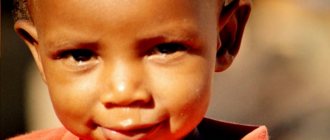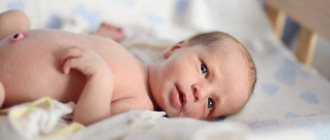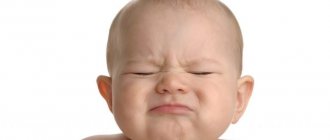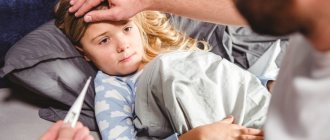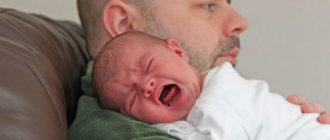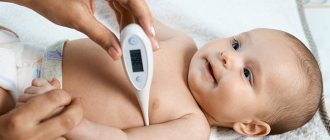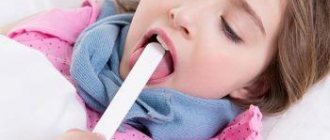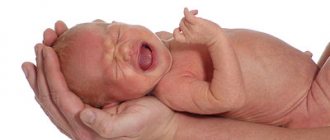The gallbladder is involved in the digestive process. The function of the organ is reduced to the accumulation of bile, which is involved in the breakdown of fats and disinfects the intestines. The gallbladder is located under the liver and connects to the duodenum, into the cavity of which bile flows from it.
A bend in the gallbladder in a child is a rare serious disease. The reasons for poor functioning of the organ are not only its twisted state, but also infectious intestinal lesions, worms, and hormonal imbalances. The organ consists of several sections - the neck, the bottom and the pear-shaped body, consisting of muscle tissue. If the examination reveals dents and deformations of the walls or bends, then the doctor makes a diagnosis - a bend in the child’s gallbladder. What it is? A dangerous condition occurs in which the free flow of bile is interrupted, it stagnates and provokes the development of stones and clots in the organ. This disease can affect both adults and children. In childhood, gallbladder bending is uncommon, but the symptoms and treatment methods should be known to parents. Sometimes the pathology is temporary and over time the organ takes on the correct shape. If this does not happen, treatment is required.
What it is?
An inflection is a change in the physiological shape of an organ. As a result of such a change, there is a violation of its functionality.
The gallbladder is important for food digestion processes.
Bile (an enzyme necessary for digestion) secreted by the liver is stored in the gallbladder and, when needed, is expelled into the digestive system.
This occurs due to the contraction of the muscle tissues that make up the organ.
If the shape of the gallbladder is disrupted, the ability to contract is reduced, therefore, the process of releasing bile into the digestive system is disrupted. This leads to disruption of the entire gastrointestinal tract system.
The disease may be single or multiple . The shape of the organ changes in various ways (in particular, the organ can resemble a horseshoe, a question mark, a hook, the letter S).
The disease can be labile , when the gallbladder periodically takes a normal, natural form for a given organ, and then returns to a pathological state, or fixed .
The fixed bending form is considered the most dangerous. If with a labile bend the gallbladder periodically empties, with a fixed form this is not possible.
Consequently, bile stagnates in the cavity of the gallbladder, stretching the walls of the organ. As a result, prerequisites are created for the development of other gallbladder diseases (cholelithiasis, cholecystitis).
Disease prognosis
Since accumulated bile interferes with the process of breaking down and digesting food, over time the level of fatty acids in the blood will begin to increase and, conversely, the rate of glucose oxidation will slow down. As a result, the following pathologies may begin to develop:
- Deterioration of vision.
- Dysfunction of the digestive organs.
- Decreased muscle tone.
- Formation of stones in the kidneys and gall bladder.
- Lag in general development.
With correctly defined therapy, the prognosis of the disease has a positive trend, and in many cases, as the child grows older, he gets rid of all the symptoms of the disease.
In the video, doctor Komarovsky explains what to do if a child has a deformed gallbladder.
bolitpechen.ru
Causes of pathology
Congenital inflection of the gallbladder develops due to improper intrauterine formation of the fetus.
The prerequisites for the occurrence of pathology appear around the 5th week of pregnancy, when the most important internal organs, such as the liver and bile ducts, are formed in the fetus.
This situation can be caused by such unfavorable factors as infectious diseases suffered by a pregnant woman at the very beginning of pregnancy, poor lifestyle of the expectant mother, uncontrolled use of medications, including vitamin complexes.
Why is it dangerous?
The greatest danger is the acquired bend that a child develops with age. The consequences in the absence of treatment are far from pleasant:
- liver enlargement;
- jaundice;
- chronic gastrointestinal diseases;
- violation of general development.
The long-term consequences can be even worse. Gradually, bile that cannot find a way out will accumulate in the body. Lipids supplied with food are not completely broken down, and large amounts of fatty acids accumulate in the blood. As a reaction to the process, the rate of glucose oxidation decreases.
What follows from this, readers, I think, have guessed: diabetes and obesity, since fats will not be absorbed, and there are not enough vitamins to dissolve fats.
At the next stage, vision, muscles, and blood vessels will suffer. If there is no treatment, cholecystitis and cholelithiasis develop.
So the question of treatment should not be before parents: they need to see a doctor and examine the baby.
Clinical manifestations
The disease does not manifest itself in any way for a long time, especially if we are talking about a labile (mobile) form of the pathology. Most often, the first signs of pathology appear in adolescence, sometimes even in adulthood.
At the same time, congenital inflection of the gallbladder does not have any clinical picture that characterizes this particular pathology; the manifestations of the disease are similar to the signs of other pathologies of this organ. The patient may be bothered by symptoms such as:
- Feeling of heaviness after eating;
- Difficulty in digesting food;
- Nausea, urge to vomit;
- Increased gas formation;
- Lack of appetite;
- Abnormal stool (constipation, or vice versa, diarrhea);
- Pain in the right hypochondrium, epigastrium.
Urgent symptoms
A bend located in the cervical area is considered the most dangerous condition, as it can lead to permanent loss of functionality of the organ, necrosis of its cells and tissues.
This condition has more pronounced symptoms:
- In the area of the right hypochondrium there is an acute and severe pain, radiating to the right shoulder blade;
- Body temperature rises;
- Change in skin color (yellowness);
- Severe diarrhea;
- Increased sweating;
- Changes in the color of stool (discoloration) and urine (darkening).
Diagnostic procedures
The standard for diagnosing kinks is ultrasound. During the examination, the specialist analyzes not only the condition of the deformed bladder, but also other adjacent organs. This allows us to give an unambiguous answer to the question about the cause of the bend.
To diagnose inflection in children, the following technique is used:
- Ultrasound is performed on an empty stomach;
- Next, the child is offered to have breakfast with food with a high concentration of fats - yolks, sour cream;
- After 15 minutes, repeat the procedure;
- The functional inflection disappears. The permanent one does not react in any way to provocation.
Additionally, laboratory tests indicate problems with the movement of bile. The most obvious indicator will be an increase in bilirubin. This is a breakdown product of hemoglobin, its increased content in the blood indicates a violation of utilization.
In the case of bile duct inflection, there is an increase in direct bilirubin due to a deterioration in its release into the intestine for excretion from the body. The child may experience an increase in the size of the gall bladder.
Diagnostics
To make a diagnosis, the doctor conducts a survey and visual examination of the patient, and palpates the area of the gallbladder. In addition, special hardware examinations are required. Ultrasound is considered the most effective method for diagnosing pathology.
This method allows you to identify the bend, determine the shape of the gallbladder, and assess its condition. To identify the type of pathology (labile or fixed), ultrasound is performed twice. The first time the study is performed on an empty stomach, the doctor records the original shape of the organ.
After this, the patient eats a breakfast of 2 egg yolks (this product is considered choleretic), and after a while is examined again. With a fixed type of pathology, the shape of the gallbladder remains unchanged.
Treatment of pathology
Most often, treatment is conservative. That is, the patient is prescribed to take special medications, follow a diet and a special lifestyle.
At home, folk recipes are widely used. In some cases, when the pathology is dangerous to the patient’s health and threatens his life, emergency surgery is prescribed.
Drug treatment
In the case of a congenital form of the pathology, the patient is prescribed drugs that facilitate the outflow of bile and the process of emptying the gallbladder, preventing the development of cholelithiasis.
Such drugs include Allochol, Gepabene. It is important to remember that the use of choleretic drugs must be prescribed by the attending physician, since these medications cannot be taken if there are stones in the gall bladder, as this can provoke blockage of the ducts of the organ.
And this is a life-threatening condition.
The patient is also prescribed drugs that change the viscosity of bile, making it more liquid (Ursohol). These products not only promote the flow of bile, but also dissolve small stones in the gallbladder area.
If the process of bile stagnation continues for a long time. An inflammatory process may occur in the gallbladder and its ducts. In this case, it is necessary to take anti-inflammatory drugs.
To relieve pain, painkillers are prescribed (No-shpa, Papaverine).
Surgery
Sometimes dangerous situations may arise when urgent surgical intervention (removal of the gallbladder) is required. This is necessary if multiple bends occur, since in this case the development of peritonitis and general severe intoxication of the body is possible.
Surgery is also prescribed when conservative treatment does not produce a positive effect, and the inflammatory process continues to develop in the area of the affected organ.
Treatment at home
A procedure such as tubage using a magnesium solution can have a positive effect. To prepare it, 20g. Magnesium sulfate is diluted in 70 - 100 ml. boiled water (proportions and quantity of the ingredient are determined depending on the patient’s body weight).
The resulting solution is drunk on an empty stomach, after which a warm heating pad is placed on the right side. The duration of the procedure is 30 minutes. A solution of magnesium has a strong choleretic effect; as a result of its action, accumulated bile is released into the digestive tract.
As a result, after the procedure, the consistency and color of stool may change; it becomes more liquid and acquires a green tint. This phenomenon is considered normal. It is important to remember that this method can only be used as prescribed by a doctor.
Contraindication – the presence of even small stones.
Do you need a diet?
Undoubtedly. Without following a special diet, successful treatment is impossible. It is necessary to avoid spicy, fatty, fried foods, spices, sweets, dried fruits, grapes, and alcohol.
It is recommended to give preference to light dishes of plant origin. This is necessary because if the gallbladder is bent, the process of digesting food is already difficult, and heavy food will create additional stress on the organs involved in its digestion.
It is important to remember to adhere to the liquid regime. It is recommended to drink at least 1.5 liters. clean water. This helps to liquefy bile and cleanse the bile ducts.
Diet
One of the most important conditions for treating bending is diet. Medicines, physical therapy and other remedies will not have the desired effect without a balanced diet.
Do not use:
- fatty, fried, spicy and salty;
- flour products, sweets;
- smoked meats;
- milk;
- carbonated drinks;
- chips and fast food.
The diet should contain:
- products that provide increased flow of bile (for example, pumpkin, which can be baked and boiled, or pumpkin juice);
- vegetables and fruits;
- a large amount of water to eliminate bile clots;
- dairy products;
- boiled and baked dishes.
Food you prepare yourself will be healthier. Dyes, preservatives and food additives in such quantities as in ready-made food in the store are harmful to a child.
A steamed omelette or oatmeal porridge in water with pieces of fruit are good options for breakfast. Porridges are especially good for this ailment. Cottage cheese is also very useful. When dying, a child can eat the following sweets: marshmallows, soufflé, soft crackers. Bananas, pears, apricots and non-acidic varieties of apples will also be good for illness.
Low-fat vegetable soups will be useful. Steamed cutlets, boiled rabbit, pork and beef are suitable. You cannot use butter or vegetable oils when cooking, but you can add a little to the plate.
The child should eat frequently, but in small portions, which will ensure normal outflow. For children with this disease, servings of up to 300 g are provided about five times a day. It is necessary to eat food that is easily and painlessly absorbed by the body.
Prevention
As is known, the prerequisites for the development of congenital pathologies are laid in the first weeks of intrauterine development of the fetus.
Therefore, the expectant mother needs to take care of her health even during pregnancy planning. And when pregnancy has occurred, it is necessary to visit a doctor in a timely manner and carefully follow all his recommendations.
